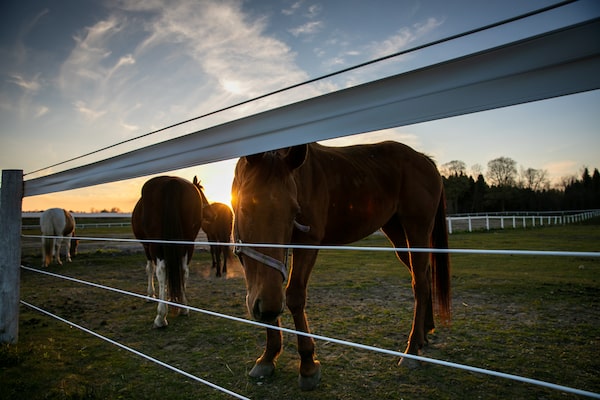
Copper peeks through a fence while out on pasture at the family-run Pickering Horse Centre near Toronto. A riding-school horse named Millbrooke recently died at the centre of what the co-owner suspects was heart failure brought about in part by the changes in lifestyle due to the farm's closing during the pandemic.Melissa Tait/The Globe and Mail/The Globe and Mail
A few times in as many weeks, veterinarian Mike Pownall’s team has put down horses with intestinal problems for one of two reasons: Cash-strapped owners either couldn’t afford the necessary surgery, or, hoping to get by without a pricey doctor’s visit, they waited too long to call for help.
Dr. Pownall and others in the equine industry have for months warned that stable owners would soon be on the verge of going out of business, with horses’ mouths still to feed. That worry is now a reality.
Stable owners whose income depends on riding lessons, summer camps and horse shows are making difficult decisions. They are rationing hay, cutting back on grain and supplements, and sending their horses to pasture early to graze. They are increasing the time between visits from the farrier, the specialist who tends to hooves; some are removing the horseshoes altogether, risking lameness to save on maintenance fees.
They are postponing vaccinations and dental work, which could lead, respectively, to cases of the deadly West Nile virus or abnormalities in the mouth that prevent proper chewing. They are selling their horses for cents on the dollar, giving them away and euthanizing older or injured animals earlier than planned. They are moving out of their homes and into their horse trailers, deferring taxes and equipment fees and cashing out their retirement plans. They are turning off the barn lights.
“This is happening now – right now,” said Dr. Pownall, a founding partner at Ontario’s McKee-Pownall Equine Services.
Wherever you live and work, chances are your workplace has been affected by the coronavirus pandemic. Many businesses have closed, either voluntarily or under provincial bans on non-essential services, and those closings and layoffs have affected hundreds of thousands of people.
- If you have been laid off, the Canada Emergency Response Benefit will help you stay afloat. And: additional career advice.
- Here’s how to apply for EI and other COVID-19 emergency government income supports
Toronto employment lawyer Daniel Lublin answered frequently asked questions about COVID-19′s impact on the work force. Some questions include:
- If my employer shuts down because of COVID-19, am I entitled to severance?
- If I have COVID-19, am I entitled to my salary while quarantined?
- What types of questions can my employer ask me related to COVID-19?
Though the federal and some provincial governments have introduced income supports for workers that don’t qualify for EI benefits, many businesses have called for larger wage subsidies to prevent layoffs, as well as a broad freeze on payments to government.
Get a second opinion:
- What are the rules around temporarily laying off employees?
- My boss wants me to self-quarantine without pay. Is that legal?
- Is this a bad time to be switching jobs?
Have a question that you’d like answered? Send them to NineToFive@globeandmail.com. You can also check The Globe and Mail’s digest of the latest news about COVID-19′s spread around the world.
Because the pandemic is such an unprecedented event, the legal landscape will be changing quickly. There may be considerations about your personal situation which make the information here inapplicable to you. To obtain advice that relates to your personal circumstances, the best route is to contact an employment lawyer.
“We’re right at the point where, best-case scenario, a lot of horses are going to go hungry, and worst-case scenario they’re sold on auction for meat or euthanized. ... It’s not neglect. It’s ‘We don’t have money.’"
When the COVID-19 pandemic first hit, businesses across all kinds of sectors did everything they could to slash expenses and stay afloat, including laying off employees to save on payroll.
But for stable owners, their core work force is equine. Their horses are out of work and are bringing in little or no income, but the cost of keeping them alive and well is fixed.
Stable owners across the country told The Globe and Mail that they understand that the coronavirus crisis is making it hard for families to put food on the table – that there is immense human suffering at the moment. They are aware that people are dying and that mourners can’t even grieve together. Cancer surgeries have been postponed. Grandparents haven’t met their grandbabies. At the same time, these businesses are drowning in expenses and are desperate for help to ensure the welfare of the animals that have for years been so integral to their businesses and so dear to their families.
“There are far more important things than riding lessons,” said Duncan Oswald, who owns the family-run Dunelm Equestrian Centre in Rigaud, Que. “But it’s close to our hearts because it’s how we earn a living and there are animals that depend on us. … They can’t fend for themselves.”
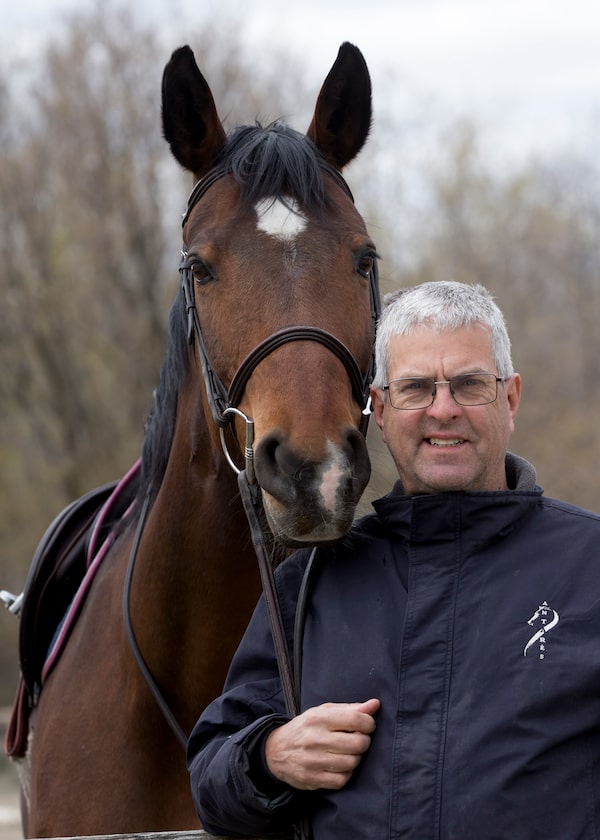
Duncan Oswald, shown with his horse Rain, worries how lost income from riding lessons will affect businesses like his.Courtesy of Cealy Tetley
Facilities in Ontario are about to get some relief. On Thursday, Premier Doug Ford unveiled the list of businesses and activities permitted to resume operations in the first phase of the province’s reopening plan. Equine facilities are included. As early as this weekend, stables can open their doors for lessons and competitions without spectators, so long as riders and their trainers are able to maintain a distance of at least two metres. (Common areas, such as washrooms, must remain closed.)
Although the announcement is good news for stable owners in the province, it does not mean a swift and assured return to normal. Parents may be reluctant to register their children for lessons or camps, whether for health or financial reasons. Diminished income is better than none, but for some facilities, it will be too little, too late.
It can cost upward of $700 a month to maintain a single horse. This doesn’t include rent or mortgage payments, utilities, payroll or equipment. Depending on the size and the services they offer – some barns also offer equine-assisted learning programs and therapy for children with autism – stables can have anywhere from just a few horses to more than a hundred. Equestrian Canada said a national survey revealed that as of early April, there were roughly 46,500 horses across 8,500 equine facilities with less than a month of financial reserves and supplies. Akin to the restaurant industry, stable owners tend to have slim margins. For most, keeping horses is a labour of love.
Still, the equine industry contributes more than $19-billion to the Canadian economy, generating tens of thousands of jobs. But unless a stable owner also reports income from farm-related activities, such as growing food or raising cattle for beef, they are ineligible for emergency agriculture support; they can’t access any of the $252-million in agri-food funding Prime Minister Justin Trudeau announced last week. The $72-million in federal emergency sport funding announced last month is for athletes and sport organizations.
Stable owners who applied for the federal wage-subsidy program are still waiting to receive the money to help pay for the staff they haven’t yet laid off. And while they may qualify for interest-free, government-backed loans, many are wary of going into debt when they know full well that they have cash-flow issues at the best of times. Some stable owners expressed fears of a slow collapse; even if the sector can claw its way through the next few months, how will it survive the winter, without the cushion from a lucrative spring and summer?
Kathryn Naud, who co-owns the A&T Equestrian Centre in Surrey, B.C., said she is among those “fighting tooth and nail” to preserve the business as she knows it. With 56 horses, it’s the largest lesson barn in the province. Faced with increased expenses from equine pregnancies and vet bills after a horse got spooked and kicked another, Ms. Naud and her family briefly considered euthanizing Doodles, a 17-year-old horse with a back injury. For horse people, compassionately putting down an animal is unquestionably better than selling it into a flooded market, where it may end up being exported to be slaughtered for meat. Ms. Naud decided to spare Doodles and keep her on as a therapy horse. “We just never wanted to be making decisions about someone’s life under the gun,” she said.
Jen Sweet cares for Billy, one of her boarding horses, at her stable in Ayr, Ont. She got a fundraising campaign started to help equestrian businesses that aren't eligible for government COVID-19 relief.Galit Rodan/The Globe and Mail
HOPE AND PRAYER
It was mid-March when Lions’ Bridge Stable owner Jen Sweet started to realize the havoc the pandemic would wreak. What would the lockdown mean for her lesson and show facility in Ayr, Ont.? How would she handle her boarder horses, whose owners might not be able to visit their own animals or afford the monthly fee? She also thought beyond herself, her business and even her species. “Oh my goodness,” she thought at the time. “What are we going to do with the schoolies?”
“Schoolies” is an endearing term for riding-school horses – the animals that give racers and recreational riders their start, that take young children for their first walk around the paddock. “These horses are our employees, but they’re also our companions,” Ms. Sweet said. “We’ve trained them and we’ve loved them and we’ve watched them give kids lessons and memories. It’s so much more than an animal in a barn. They’re not replaceable.”
She hastily launched Helping The Schoolies, which effectively turned her into a broker who paired needy stables with donors of money and essentials. The Facebook group grew to 1,500 members in a matter of two days. By mid-April, Ontario Equestrian reached out to formalize and expand the initiative, now dubbed For The Herd. The fundraising drive has raised more than $100,000 in recent weeks, and has so far received more than 85 funding applications from stable owners across the province. Such intervention, Ms. Sweet said, is necessary. “Can you imagine getting up every day and looking at your 30 horses and thinking, ‘How am I going to feed you?’" said Ms. Sweet, who has managed to maintain some income because she boards horses, unlike owners that run strictly riding-lesson barns. “The thought of losing [the business] like this, when they have done nothing wrong, is devastating.”
Ms. Sweet said she understands that owners are in a precarious position, but she fears that if they offload too many horses, they’ll be at a major disadvantage when lessons resume and the demand for programming returns. “You might have to sell a couple to feed the rest, but they’re your employees,” she said. “They’re your only ticket out of this, at the end.” She said that while she welcomes Mr. Ford’s announcement this week, the equine sector will need continuing support to recover from the damage done in recent months. “It will take everyone a long time to get back to normal,” she said.
One stable owner has already sold or given away nine horses and ponies, and the family-owned business is looking to sell another dozen as soon as possible. The man, who is not being identified because of privacy concerns and fears of repercussions for his business, said he intends to euthanize five or six older horses in the coming days – a fate that was always on the horizon, only now it’s coming sooner. He plans to put them down as a group, because it is cheaper that way.
Summer camp registrations at the facility are currently down roughly 80 per cent. The situation is so dire that he’s not sure he’ll be able to reopen at all. He will run out of hay in less than two weeks; he’s hoping that the grass will come in soon, so he can put his horses to pasture earlier than usual.
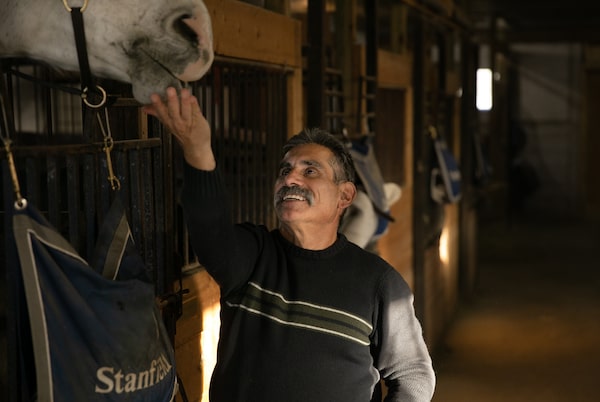
Gary Yaghdjian, co-owner of the Pickering Horse Centre, feeds a snack to boarder horse Stanfield as he closes down the stable for the evening.Melissa Tait/The Globe and Mail
At another facility, the pasture is doubling as a graveyard. Last weekend, Gary Yaghdjian, co-owner of Ontario’s family-run Pickering Horse Centre, lost one of his mares, a schoolie in her 20s named Millbrooke. She was found dead in the field, near the round bale of hay she shared with a half-dozen other mares. Mr. Yaghdjian used his backhoe to bury her on the spot. Doing so saved him $500 in removal fees. “It never gets easy,” he said of losing a horse. “I’ve been in this for 42 years, and it never gets easy.” He suspects she died of a heart attack, caused, at least in part, by drastic changes in her lifestyle brought by the pandemic. But he will never know for sure. The family couldn’t justify spending thousands of dollars on an autopsy.
Before the COVID-19 lockdown, Millbrooke got exercise, care and affection pretty much every day; at the end, she was out on the field with the other mares and was brought into the stable a few times a week. “Horses are such immensely social, habit-oriented creatures,” Mr. Yaghdjian said. “I’m certain that she was relying on that exercise to stimulate her metabolism, and I’m certain her emotional status was reliant on all the interaction she had with the kids.” Imported from Germany as a youngster in her prime, Millbrooke competed at the highest levels in jumping circles until she was sidelined by an injury. She had been a lesson horse at the facility for eight years.
Running the centre, with its 28 lesson horses and 18 boarders, typically costs roughly $65,000 each month. Through tax deferrals and other measures, the family has managed to get their expenses down to $45,000. With no income from lessons, shows and camps, the centre has been losing $35,000 each month. Mr. Yaghdjian has accessed a $40,000 federal loan, but it will have to be repaid, along with all the other expenses he has put off. “It’s all piling up,” he said. But the family made a pact at the outset of the pandemic, and they will do everything they can – sell all their personal effects – before they’ll break it: Keep the humans and horses healthy, and don’t lose the farm. “We’re all in,” he said.

Millbrooke's stall lies empty after she was buried on the farm.Melissa Tait/The Globe and Mail
The Halifax Junior Bengal Lancers, a not-for-profit riding school in Nova Scotia’s capital city, doesn’t even have the option of putting its horses to pasture. It’s located downtown. So far, executive director Angie Holt said, all 27 horses have had their grain rations cut (the horses are working much less, so they don’t need as much food). All of the horses are also now barefoot in order to save on farrier fees, but it could have the reverse effect if any of them develop hoof problems (it costs roughly $40 to trim a horse’s hooves, and $120 to remove and re-iron a set of horseshoes). Half of the horses had already gotten their annual vaccinations and dental work before the pandemic hit; the appointment for the other half, scheduled for late March, was cancelled. “We now have a risk of a horse developing dental issues that we would have caught had we had the regular visit,” Ms. Holt said, adding that since the horses live in the city, they’re unlikely to contract mosquito-borne diseases.
The not-for-profit charges monthly membership fees of anywhere between $180 and $350 dollars, but for now, it is asking riders to pay $50 a month to cover the cost of maintaining the herd. “Our horses still have to be cared for every day,” she said, “regardless of whether we’re offering services to humans.”

Roetka Gradstein and her daughters Aminata and Subira Karakach are seen with Inga, a lesson horse who is also used for equine therapy at the Halifax Junior Bengal Lancers stable.Courtesy of Angie Holt/The Globe and Mail
Ms. Naud, from A&T Equestrian in B.C., said it is costing tens of thousands of dollars each month just to feed her horses and provide them with proper bedding – the shavings that absorb urine and moisture to keep a healthy stall. She has a mortgage, employees and utility bills to pay. The lights go on for the early morning feed, but as soon as the sun comes up, the lights go back off. She has had the shoes removed from some of her horses to reduce her farrier fees. Smaller lesson barns have asked A&T to please, please, please buy their herd at a massive discount. Ms. Naud has turned them all down. “We’re unfortunately not in a position to take on any more mouths to feed,” she said.
Relatives have provided cash to help cover the operating expenses, but that support won’t last forever. Ms. Naud launched an online adopt-a-pony program that includes updates and photos in exchange for anywhere between $19.95 and $34.95 a month. The adoption site brings in about $2,500 monthly. For the Mother’s Day weekend, A&T also opened up its property for picnics, allotting one acre for each $50 booking in order to facilitate physical distancing. Families brought their own blankets and refreshments. The festivities brought in roughly $1,000 – about a tenth of what the facility would earn over a full weekend of lessons, birthday parties and events. Ms. Naud said she’s holding out hope that the federal government will wake up to the crisis facing the equine industry and provide badly needed assistance.
“It’s a lot of hope and prayer right now,” she said.
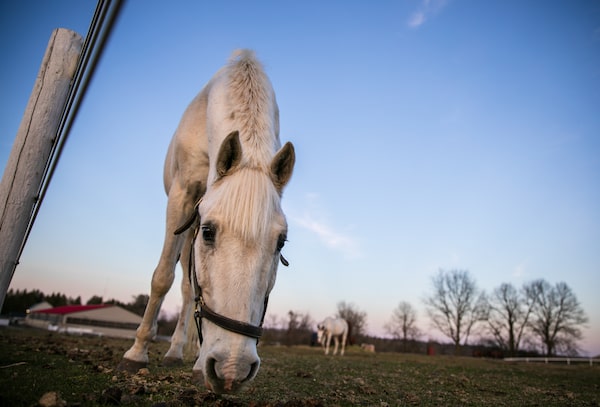
Danny grazes with some of the other riding-school geldings at the Pickering Horse Centre. National groups like Equestrian Canada have been pressing the federal government for more help to struggling stable owners.Melissa Tait/The Globe and Mail/The Globe and Mail
FALLING THROUGH THE CRACKS
In a March 18 letter to Agriculture Minister Marie-Claude Bibeau, Equestrian Canada asked Ottawa to provide financial support for the industry, including subsidies for necessities such as hay and bedding. “The equine commercial farming sector is facing a grave reality and catastrophic animal welfare concerns,” the national organization said in the letter. Kristy House, Equestrian Canada’s manager of welfare, said Facebook groups are rife with posts from struggling stable owners looking to sell their horses. “What we’re trying to get through to the government is that they need to intervene before euthanasia really starts happening,” she said.
In a statement, the federal agriculture department said it is working with equine-sector representatives to explore how programs such as the Canada Emergency Response Benefit and the Canada Emergency Commercial Rent Assistance program might support those with farm operations or agribusinesses. “We are also raising this issue with our provincial counterparts,” the department said. The statement described the horse sector as “very diverse and unique, touching on sport, recreation, tourism, racing and agriculture.” That reach is precisely the problem. “We fall through the cracks,” Ms. Sweet said. The agriculture department referred The Globe to Sport Canada, which falls under Canadian Heritage, for more information about Ottawa’s role in supporting the industry.
In an e-mail, the heritage department noted that the government last month announced a $500-million emergency support fund for cultural, heritage and sport organizations, with $72-million earmarked for the sport sector. That money, however, is only available to athletes, national organizations that already receive funding under existing Canadian Heritage programs and, indirectly, provincial and territorial sport groups. National organizations such as Equestrian Canada can apply for up to 25 per cent of their 2019-20 funding, based on demonstration of need. “The fund complements the government’s existing COVID-19 support measures and is not intended to support businesses at the local level directly,” the department said.
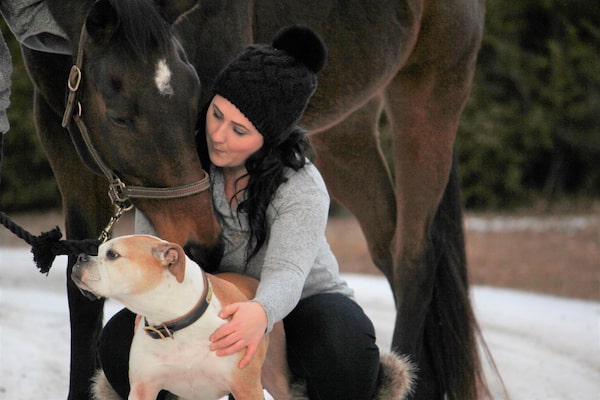
Kristy House hugs Prince the horse at her boarding and training facility in Prescott, Ont.Kristy House
Provincially, industry groups are lobbying for help, too. The Saskatchewan Horse Federation is calling on the province to include equestrian facilities, alongside golf courses, in the list of businesses permitted to resume operations in the first phase of reopening the economy.
In Quebec, where some elementary schools and daycares have just reopened, Mr. Oswald has already resumed coaching – albeit only as of last week, and at a much-reduced capacity. His experience provides a glimpse into what a resumption of outdoor recreation in other provinces might look like when the time comes. Only a few people are allowed in the barn at once, and he is only permitted to teach those who board horses at the facility. With the recreational riding school still closed, his 15 lesson horses remain without a job. “All they’re doing is eating hay,” he said.
Mr. Oswald is 50, with a high-school education. Horses are all he knows; he inherited his love for the animals from his mother. “You’re living day to day, but it sure beats working," he said. “I never have to put on a tie or fight traffic. It’s a lifestyle. I’m never going to retire to Florida, and I’m fine with that.” All of his income comes from the equine sector, whether through teaching, coaching, transporting horses or managing shows. It is unclear when competitions will resume. “This is people’s play money,” he said. “My die-hards will come back, but my casual riders? Nobody has play money right now, and I don’t blame them. ... Everybody is in the same boat. Every industry is in the same boat.”
If stables are able to ramp up their services soon, he and other owners will be in better shape, he said. But that won’t mean the industry is out of the woods. The real test, he said, will come when winter arrives – when stable owners won’t have their usual high-season earnings to carry them through the colder months. “That’s when we’re really going to see how bad this was,” he said.
In depth: Hard times for horse people
Watch: Photojournalist Melissa Tait visited the Pickering Horse Centre, where there are 29 riding school horses with no students to exercise them. There is optimism with Ontario's new reopening plans, but the losses have been heavy.
The Globe and Mail
Sign up for the Coronavirus Update newsletter to read the day’s essential coronavirus news, features and explainers written by Globe reporters.